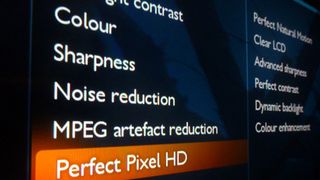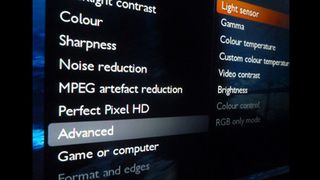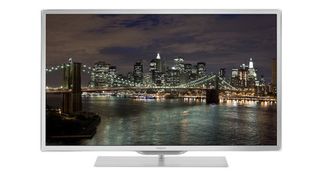Why you can trust TechRadar
In our often gloomy Blu-ray test disc War Horse we immediately discovered that the Moth Eye and Micro Dimming Premium technologies are indeed an advance on last year's flagship attempt. Areas of black during sequences of Joey galloping through no-man's land are utterly profound, while shadow detail in the shirt of a farmer in a gloomy stable also impresses.
However, peak whites are just as pure, with mixed brightness images the most impressive; the farmer's stable is dark, but bright light streams in from a series of small windows - and still there's profound black on either side.
We noticed only a small amount of haloing and glare around the brightest of white segments within an image that boasts luscious, subtle colouring as well as excellent contrast and black levels.

This is direct LED local dimming - a tech that's virtually died out among other brands - at its unbeatable best, though arguably it's still not as fluid a picture as, say, a top-end Panasonic plasma TV.
In War Horse, as Albert runs out of the farm, arms flailing behind him, there's a distinct flicker, and when he arrives in the village there's an uncomfortable shimmer around him as he swivels and stops.
This is down to some frame interpolation tech called Perfect Natural Motion (PNM) being on its highest setting; for most films it's best left on its lowest setting - or de-activated, as it is on our preset picture mode of choice, ISF Night.

We found that War Horse was smoother with PNM on its minimum power, though in some sequences it worked well even on full power. A jerky, high-paced sequence involving a calvary invasion of an army camp is made watchable by PNM, while watching the same scenes jerk and judder without it activated seems a step backwards.
That's not to say that PNM doesn't introduce some flicker around moving objects. It definitely does, but it's worth auditioning to see whether its smother, video-like imagery is to your taste.
Reflections, too, are kept to an absolute minimum in daylight, though the Philips 46PFL9707's impressive images are still best viewed in dingy light with ISF Night mode, and with both Perfect Contrast and the Dynamic Backlight disengaged; the latter tends to introduce crushed blacks and a loss of shadow detail.

Granted, it does take some experimenting and the odd tweak here and there, but the best aspect about this potentially complicated TV is that its images rarely look processed. And that, as anyone who's encountered Pixel Plus through the ages, is a rare feat.
Put all of this together and we'd judge the Philips 46PFL9707 as having the finest 2D Blu-ray performance of any LCD-based TV on the planet.
Unfortunately that doesn't extend to 3D. Turning to a 3D Blu-ray disc of Hugo, we tinkered with two key settings beyond the '3D Experience' tab; Max Clarity and Flicker Free - and it's a straight choice between the two.

In whatever conditions we tried, Flicker Free introduced crosstalk, where images meant for one eye can be seen by the other, and vice versa. Yuck.
The opening panoramic sequence to Hugo is impressive in either mode, but as soon as actors and close-ups are introduced, it's got to be Max Clarity - and even then we noticed some image echos. Oddly we didn't get distracted by flicker on Max Clarity, anyway.
Either way, a quick blast of PNM on its medium setting makes 3D more fluid and watchable, though it can't do much about that crosstalk.
Jamie is a freelance tech, travel and space journalist based in the UK. He’s been writing regularly for Techradar since it was launched in 2008 and also writes regularly for Forbes, The Telegraph, the South China Morning Post, Sky & Telescope and the Sky At Night magazine as well as other Future titles T3, Digital Camera World, All About Space and Space.com. He also edits two of his own websites, TravGear.com and WhenIsTheNextEclipse.com that reflect his obsession with travel gear and solar eclipse travel. He is the author of A Stargazing Program For Beginners (Springer, 2015),

This has to be the most absurd portable power station ever launched — Asus's Mjolnir throws the hammer at rivals with innovative design that's likely to divide opinions

Pixel's new satellite feature could show people where you are on Google Maps

I really hope Google doesn't promise 7 years of Android for the Pixel 8a

